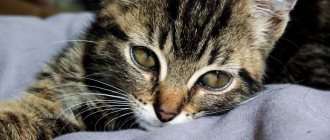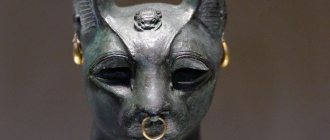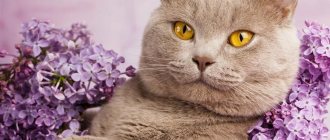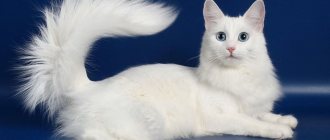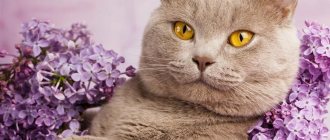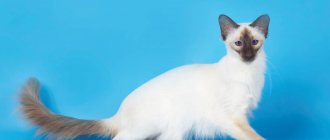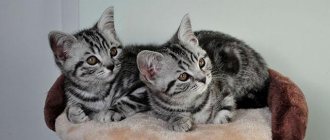The European Shorthair (Celtic) is a breed of domestic cat, developed through selective breeding in the middle of the last century. These are graceful creatures that combine excellent hunting qualities, friendliness and high intelligence. Compared to exotic breeds, Europeans look quite simple, but this is exactly the image that comes to mind when talking about domestic cats.
Brief history of the breed
The ancestors of the European or Celtic shorthaired breed were ordinary yard cats that lived side by side with humans in Northern Europe since the times of Ancient Rome.
Basically, people valued them for their hunting qualities - the animals exterminated rats and mice.
During the dark period of the Middle Ages, the number of cats decreased noticeably due to the efforts of the Inquisition. All black animals were declared accomplices of the devil and sent to the stake.
Over time, the population size recovered, and by the middle of the 19th century, first amateur breeders and then specialists paid attention to the characteristic animals. By the end of the century, the European cat was presented at exhibitions, but it did not receive official recognition as a breed.
At the beginning of the 20th century, felinologists in Denmark, Norway and Sweden seriously began breeding the breed. In 1946, Swedish breeders first registered the domestic cat. Later it received the name European Shorthair. The American line of selection also stood out separately.
Subsequently, the selection principles of British, American and Scandinavian felinologists diverged. To avoid confusion, the World Cat Federation has registered the Scandinavian breed as the "Celtic Shorthair". This includes animals that live in a specific area and meet fixed standards.
Thus, both names of the breed ─ European and Celtic Shorthair ─ are correct and equivalent.
Diseases
The ancestors of Europeans are ordinary domestic cats, which passed on excellent health and strong immunity. As a rule, they do not have any genetic abnormalities.
In order for your pet to be healthy, it must be regularly shown to the veterinarian, vaccinated, treated for ticks and fleas, and given anthelmintics.
Representatives of this breed live on average 14-15 years, sometimes living up to 20 years or more.
Interesting Facts
Fans of purring creatures will be interested in the following information:
- It is surprising that the oldest breed in the world, the European Aboriginal, is also the youngest. It received its official name ─ “European or Celtic shorthair cat” in 1982;
- There is another variety of European cat - longhaired. This is a relative of the elegant “Celt” - a Siberian breed popular in Russia. It is widespread both in the Eastern European part of the continent and beyond the Urals;
- The Celtic Shorthair is more of a companion than a relative. This is her character, free and independent;
- On the scale of temperament, Celtic Shorthairs occupy the golden mean: affectionate without intrusiveness and leaders in spirit, but not aggressive.
Price
Since there is little interest in the breed in Russia, there are few nurseries. At the poultry market they allegedly offer kittens of this breed at a price of about 2 thousand rubles. However, in most cases there is no need to rely on pedigree.
It’s not easy to buy a purebred Celt in Russia.
A purebred shorthaired European “with a guarantee” can only be purchased in foreign nurseries. However, there the price will be much higher - from 30 thousand in ruble equivalent.
Breed description, standards, appearance
Ideally, the standards for Celtic longhair cats include the absence of admixtures from other breeding lines. Working on the main characteristics of the European breed, breeders tried to consolidate the following features:
- unsurpassed trapping and hunting qualities;
- equanimity, stress resistance;
- attachment to home; I had to work hard on this quality, because the Celts are prone to vagrancy.
Dimensions and weight
Celtic cats are distinguished from other breeds by their pronounced sexual dimorphism. Females and males are very different from each other.
The Celtic cat breed ranges in size from medium to large. The girls are gracefully built, their standard weight is about 4 kg. European shorthair cats have a more powerful build, their weight is up to 8 kg.
Anatomical characteristics
Main characteristics in the description of the Celtic breed:
- the body is flexible, muscular, “high-slung”, with a straight back;
- developed, convex chest;
- strong limbs of medium length, tapering downwards, paws rounded;
- large head with pronounced cheeks, the transition from forehead to nose, large chin stand out in profile;
- The tail, wide at the base, tapers and rounds towards the tip;
- ears in the shape of an isosceles triangle, the distance between them is equal to the width of the ear. Tassels at the tips are acceptable, vertical fit;
- the eyes are slightly slanted and rounded. Their color should match the coat color. They are often green, blue, honey-amber. Heterochromia (eyes of different colors) is allowed.
Color and coat type
Representatives of the Celtic line have a dense, thick and short coat. The slightly pronounced undercoat determines its adherence to the body, elasticity and noble shine.
The standard includes more than 50 types of colors in natural shades. Range - from white to black. Some breeders of the European branch give preference to one particular rare color. They make it their trademark.
The most valuable are white European cats and tabby-colored animals: silver, golden, marbled.
Possible breed defects
Flaws that deviate from the standards of the European or Celtic Shorthair cat breed include:
- too wide muzzle ─ this is a sign of the British line of selection;
- visible signs of admixtures of other breeds;
- creases along the length of the tail, the presence of a tassel on it;
- white spots in the color: only the main background can be of this color;
- saggy cheeks.
Also, if all the standard external characteristics are present, the following colors are considered unacceptable in the Celtic line:
- faun (lightened beige);
- chocolate;
- Siamese;
- red or brown-red;
- lilac.
Character and temperament
The European Shorthair cat is intelligent and independent. She is calm and has self-esteem.
Having appeared in the house, the Celtic handsome man chooses a leader, a leader from among the family members. The owner becomes the idol of the European cat: the pet takes on the character, habits and temperament of the owner.
The animal easily adapts to the regime and conditions in the family, is emotionally involved in the relationship, but is not imposed. The short-haired pet tolerates loneliness well, does not get bored without company, and knows how to keep itself busy. Pets of the European breed are ideal for people who spend a lot of time at work.
Possessing a keen sense of territory, the Shorthaired Celt will not tolerate a competitor near him. Therefore, you should not buy another purr or puppy for a house where a cat of the European breed already lives.
Smaller animals: birds, hamsters or rats ─ should also be kept away, and it is better not to be kept in the same house as a Celtic cat. Her innate instinct as a predatory mousetrap will leave them no chance.
Despite such a harsh disposition, European Shorthair cats are sociable, playful and inquisitive. They will be happy to play with the baby. When communicating with children, the Celtic cat shows remarkable patience. He will not respond to aggression, he will simply leave the offender.
This pet does not tolerate familiarity and prefers partnerships.
A valuable quality of European shorthair cats is their silence. They will not meow without a good reason.
Personality of Norwegian Forest Cats
Norwegian forest cat with a person
Speaking about the inner world of Stogkatts, first of all, it is worth noting that by their temperament they are typical children of Scandinavia. Balanced, outwardly they rarely show emotions, prefer not to get involved in conflicts, treat others kindly, but do not tolerate violations of the boundaries of personal space - in a word, the character is Nordic.
Since Norwegian Forest Cats have long been left solely to the care of nature, they have a fairly strong desire for a “wild” life. Of course, Norwegians can be kept in a city apartment, but they will feel most comfortable in a private home, where they have the opportunity to go for walks every day and hone their hunting skills. In this case, do not be alarmed if your pet disappears from sight for several hours or even a whole day - periods of independence and “roaming” are completely normal for representatives of this breed. But at other times, you may well receive a severe reprimand for a long absence, because Norwegian forest cats really don’t like being alone when the soul requires company. A particularly acute reaction is caused by the absence of the “main person” - that family member whom everyone’s favorite person distinguishes with his deep affection and with whom he spends his evening rest more willingly than with others.
In general, Norwegian forest cats are very friendly and are perfect for living in a large family with small children and other animals. In response to obsessive attention from children or dogs, you will not see aggression; Norwegians prefer to retreat and wait out the unpleasant situation in a secluded place.
Norwegian Forest kitten with dog
If you want to teach your cat funny tricks and basic commands, choose anyone other than Norwegian cats. Understanding perfectly well what they want to achieve from them with words and treats, these wayward northerners simply ignore the trainer. They make their own decisions and refuse to obey the whims of others.
High intelligence goes hand in hand with curiosity and excellent memory. Skogkatts like to monitor the movements and habits of household members; they know exactly what order of things is typical in their home, and immediately draw the owner’s attention to any deviations from the norm, be it water dripping from somewhere or a bag of groceries left for a long time in the middle of the room. Norwegian forest cats have a quiet voice compared to other relatives, and they do not use “sound notifications” too often, so they will not bother their neighbors with their concerts in vain.
Breeders note the playful disposition of this breed, and it is not strictly tied to age. Even older cats (if their health allows them) with great pleasure and enthusiasm of a small kitten hunt for toy mice, balls and the mark of a laser pointer.
Care and maintenance
The main difference between the Celtic breed and others is its love for walks. European cats should be taken outside several times a week. They quickly get used to a harness and leash, and walks with their owner give them pleasure.
Otherwise, short-haired European purrs do not require any special conditions. Of course, the basic rules for caring for domestic cats will have to be followed:
- need to take care of the coat. To keep the coat of a European smooth-haired cat always shiny, it is enough to comb it with a special brush once a week, and during the molting period - every day;
- Regular care of ears, eyes and teeth is required, either on your own or with the help of a veterinarian;
- You need to trim your claws with special tweezers once a month. There must be a scratching post in the house;
- It is often impossible to bathe a Celtic Shorthair cat: this has a bad effect on the quality of the coat. One procedure every six months is enough;
- Vaccinations and antiparasitic measures should be carried out on time. The schedule of procedures will be drawn up by a veterinarian. The first vaccination is carried out on a kitten at the age of 2-3 months.
The European Shorthair cat, like any other cat, must have permanent places for feeding, toileting and resting. The bed should be placed away from heating devices, but not in a draft. The entire room should be visible from it. This will allow the European pet to feel safe.
Caring for European Shorthair cats
Celtic cats do not require any special care. In addition, they may pretend that they do not need their owner's attention at all, although this is definitely not the case. They cannot clean their own ears or trim their nails, and they are unlikely to be able to bathe on their own.
Experts say that these cats do not need to be bathed often. Once every six months is more than enough.
Frequent bathing will immediately affect your pet's fur, it will become degreased, and the hairs will begin to break. Therefore, systematic water procedures should be replaced with regular combing.
How to choose the right kitten
For a purebred Celtic Shorthair kitten, you should contact only special nurseries or trusted breeders.
The key to making the right choice is that the parents of the European baby have the appropriate documents about the breed ─ passports or certificates. They are transferred to the buyer upon sale.
You should pay attention to the appearance of the mother. There must be pronounced signs of the European Shorthair breed and compliance with the standards.
Typically, kittens are weaned from their mother and sold at 2.5 months. By this time, children are supposed to undergo anthelmintic treatment and vaccination and have a certificate about this from a veterinarian. The short-haired European animal must be litter trained and feed on its own.
The character of a two to three month old Celtic kitten is already clearly expressed. The future owner chooses a companion in accordance with his own temperament and needs.
Kitten care
No special skills are required in caring for a short-haired European baby. All he needs is attention and affection. At first, the new owner will have to replace the European kitten’s mother ─ kind, but strict.
It is immediately necessary to determine the place of feeding and toilet for the pet and ensure strict compliance with the rules.
At first, you will have to devote more time to your short-haired European baby, pick him up more often, and stroke his tummy so that there are no problems with stool.
Later, when the new tenant gets comfortable in the house, he will find something to do with himself. To keep your little Celtic European physically active, you can purchase several toys.
In general, caring for kittens is the same as for adult European purrs.
A short-haired Celtic baby should be fed frequently, in small portions, by chopping the food. Experienced breeders recommend leaving food overnight. Special food for kittens, dry and wet, is best suited for nutrition.
Your veterinarian will recommend vitamin supplements. Babies have a high metabolism, they quickly become hungry. After changing teeth, at 7-8 months of age, a European kitten can be switched to adult food.
Where to buy a kitten
The search for nurseries will not be successful. Turning to well-known classifieds sites can be risky. In our country, Celts are being spread through the efforts of private breeders. The main thing is to choose a reliable one who has all the necessary documents, pedigree, and a positive history.
Cost of a kitten
There are currently no professional nurseries in Russia that are engaged in breeding “Europeans”. They can be found in states bordering us, for example, in Belarus and Sweden. The cost of kittens is small, from 25,000 rubles. To this amount you need to add transportation costs.
How to name
Buying a pet for a family is a joyful event. But behind this lies the main question - what to name the new family member. It is important to observe some features of choosing a nickname:
- the name must be euphonious;
- the presence of hissing sounds in the nickname since cats understand them better;
- “brutal” names are suitable for boys, and gentle ones for girls.
It is important to pay attention to the length; it should not be too long or difficult to pronounce. A cat may simply not respond to such a name.
European adult cat.
Usually kittens are already given nicknames at the nursery. But if you wish, you can call him by his home name, which is closer in spirit and more pleasant to the ear. The table below shows popular nicknames for European cats and cats:
Popular nicknames for cats.
Here you can read about the American Bobtail cat breed.
Feeding the cat
The European Shorthair is unpretentious in nutrition, has a good appetite and is not susceptible to diseases of the gastrointestinal tract. She does not need to follow a special diet. If desired, the owner can choose one of two feeding options for the Celtic Shorthair cat:
- ready-made food, a wide range of which is presented in special departments of any supermarket. It's not too budget-friendly, but convenient;
- table made from natural products. It will take time to prepare, but it is accessible, healthy and inexpensive.
Natural food for the Celtic Shorthair includes:
- boiled or scalded meat and offal;
- vegetables (except legumes and eggplants);
- boiled fish;
- cereal porridges and soups;
- dairy products.
The natural diet of a European cat must be supplemented with vitamin and mineral complexes. You can buy them at veterinary pharmacies.
To avoid health problems for the short-haired purr, the following are strictly prohibited:
- all products from the master's table, especially smoked meats, sausages, fried, fatty and sweet foods;
- milk: some animals are lactose intolerant;
- raw fish: the risk of helminth infection is significant.
An adult European cat should be fed 2-3 times a day. Clean water must be available at all times.
Catering
The greatest care for teeth is needed when eating natural products. In this case, cats are allowed to eat:
- meat and offal: beef, chicken, turkey, rabbit, veal three times a week, raw or boiled (from 30 grams for a kitten, 100 grams for an adult);
- sea fish: hake, trout, salmon, cod, salmon once a week;
- fermented milk products of medium fat content without flavorings or dyes: kefir, fermented baked milk, cream, sour cream, yogurt, cottage cheese can be given daily;
- boiled eggs 1-2 times a week;
- cereals, porridges: millet, oatmeal, rice, pearl barley, buckwheat several times a week with the addition of olive or vegetable oil;
- vegetables, stewed, boiled or raw: pumpkin, carrots, zucchini, green beans, cauliflower;
- Vitamin supplements and sprouted greens are given in the food in consultation with the veterinarian.
Healthy European Shorthair cat
What human food should kittens not eat:
- meat waste: tripe, bones, skin, lard;
- fatty foods: mayonnaise, avocado, pork and others;
- products with a large number of flavoring additives: sweets, baked goods, smoked products, sausages, sausages, spices (salt, sugar, sauces);
- a number of vegetables: potatoes, legumes, tomatoes, eggplants.
Increasingly, veterinarians recommend maintaining a balanced diet for your pet not with natural products, but with industrially produced food. Although Europeans are not inclined to overeat, and also do not have any special dietary instructions, ready-made food is much better thought out in terms of the amount of useful microelements. With them, the cat will not need additional feeding.
Ready-made feeds come in the following types:
- Holistics are the best in quality. In addition to fresh dehydrated meat, fish, vegetables or fruits, they use vitamin and mineral supplements.
- Super premium. They differ from the former in smaller amount of meat, but in the same quality and composition of nutrients.
- Premium and Economy. They cost much less, but the ingredients used are not the best meat parts. Often such foods cause an allergic reaction in a pet.
When choosing industrial food, be guided by the weight, age and health indicators indicated on the packaging, as well as reviews from experienced owners.
Education and physical activity
Representatives of the European Shorthair breed are intelligent, smart and independent. In the process of raising and communicating with a Celtic cat, you need to be respectful and patient. The animal is well versed in the intonations of the human voice.
Demandingness and affection, perseverance and consistency will help in raising an obedient and equal family member. Screaming and rough handling will make a neurasthenic out of the Celtic Shorthair.
To prevent your cat from damaging the furniture, you need to purchase a scratching post. The European Shorthair should be provided with a place for outdoor games and climbing. It is necessary to remove all objects that could break from horizontal surfaces. Wires from electrical appliances are supposed to be hidden from the Celtic cat.
The ideal option would be to purchase a special complex for cats. Pet stores have a large selection of interactive toys. Having fun with them, a European shorthair cat can keep itself busy for a long time.
Sterilization and castration
If the owner of the Celtic beauty does not plan to regularly produce offspring, the animal should be sterilized (cat) or neutered (male). This can be done when the European pet reaches the age of 8-9 months. The time for the operation must be chosen correctly: females should not be in heat, and males should not be in heat.
There is no need to be afraid of interference. If it is performed by an experienced specialist under anesthesia, it will not cause harm.
It is much more dangerous to regularly suppress the sexual instinct with hormonal drugs. If used frequently, they can cause irreversible changes in the body of a European cat.
Tumor and cystic formations often occur in the abdominal cavity. In this case, complex surgical intervention cannot be avoided, and the postoperative period will be difficult.
Pros and cons of the breed
Naturally, keeping any animal in the house introduces some inconveniences into the family’s usual way of life. But what are small everyday problems worth compared to the happiness of communicating with wonderful cats!
Of course, you need to choose a pet with open eyes, clearly understanding the pros and cons of a particular breed. The Celtic Shorthair cat has virtually no disadvantages.
| Advantages | Flaws |
| Good health, absence of genetically determined diseases | Sometimes too independent and stubborn |
| Does not require large material costs or special efforts to maintain | It may be difficult to acquire a purebred European smoothhair cat |
| Hardly suitable for show enthusiasts and breeders. | |
| The European cat breed is unpretentious in nutrition | The Celtic breed is not popular among domestic breeders |
| Good-natured disposition. Affectionate without intrusiveness | |
| Self-sufficient, independent | |
| Silent, rarely meow | |
| Loyal to their master |
The character of a Celtic cat is a reflection of the soul and temperament of its owner. Its peculiarity is the combination of incongruous things: devotion and independence, gentleness, accommodatingness and stubbornness. European purrs respond to affection and love in full reciprocity.
The cheerfulness of the Celtic Shorthair cat is captivating. Kind, smart, but at the same time crafty and independent, Celts are ideal for keeping in a family.
There is nothing exotic in the appearance of European shorthair cats. But they have lived next to a person for so many centuries that, looking into their eyes, you can see the Soul.
Health and illness
The average European cat lives about 15-17 years. The main factor in life expectancy is proper care, vaccination, and a balanced diet. It is important to keep all required vaccinations, regardless of whether the cat goes outside or not.
The infection can enter on the wearer's clothing or shoes or through other routes. There are no hereditary diseases in the Celtic breed. Basically, health suffers from diseases characteristic of all cats, such as urolithiasis, which is provoked by poor diet.
European tortoiseshell cat.

